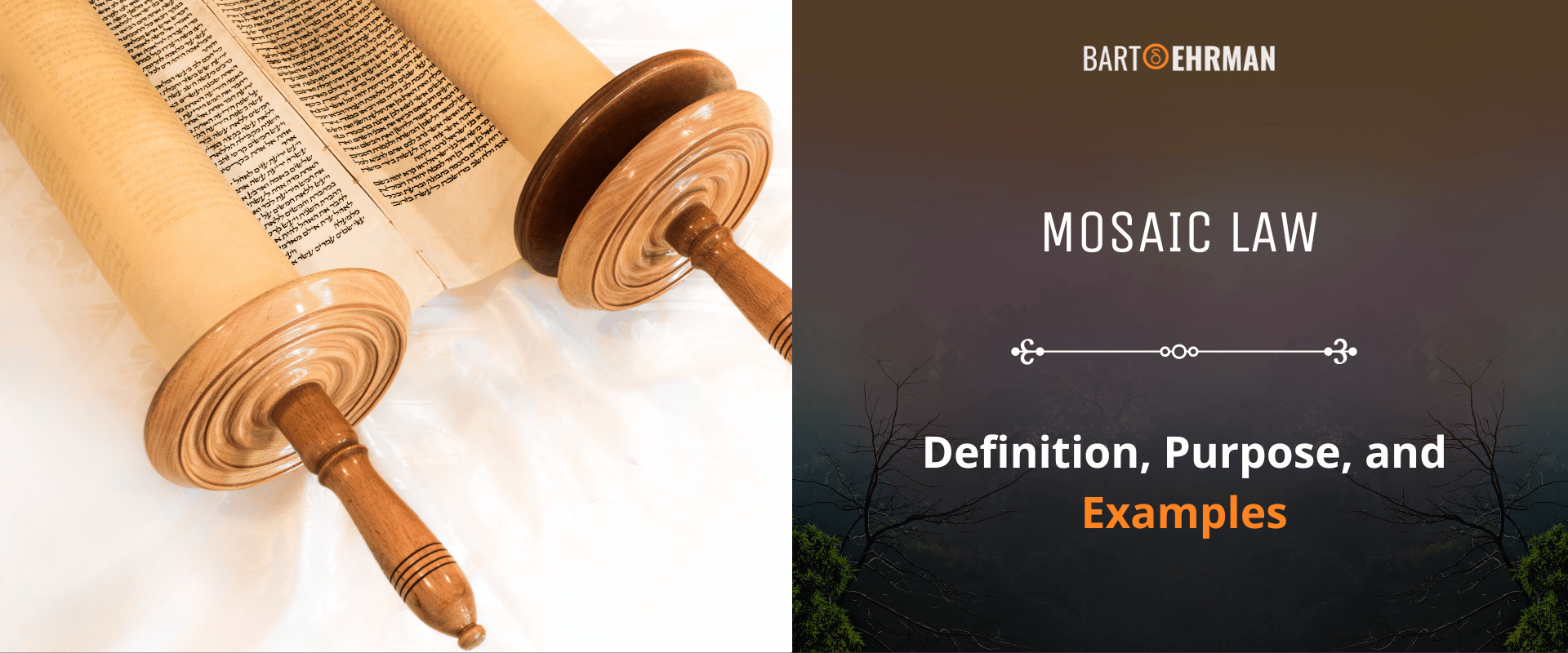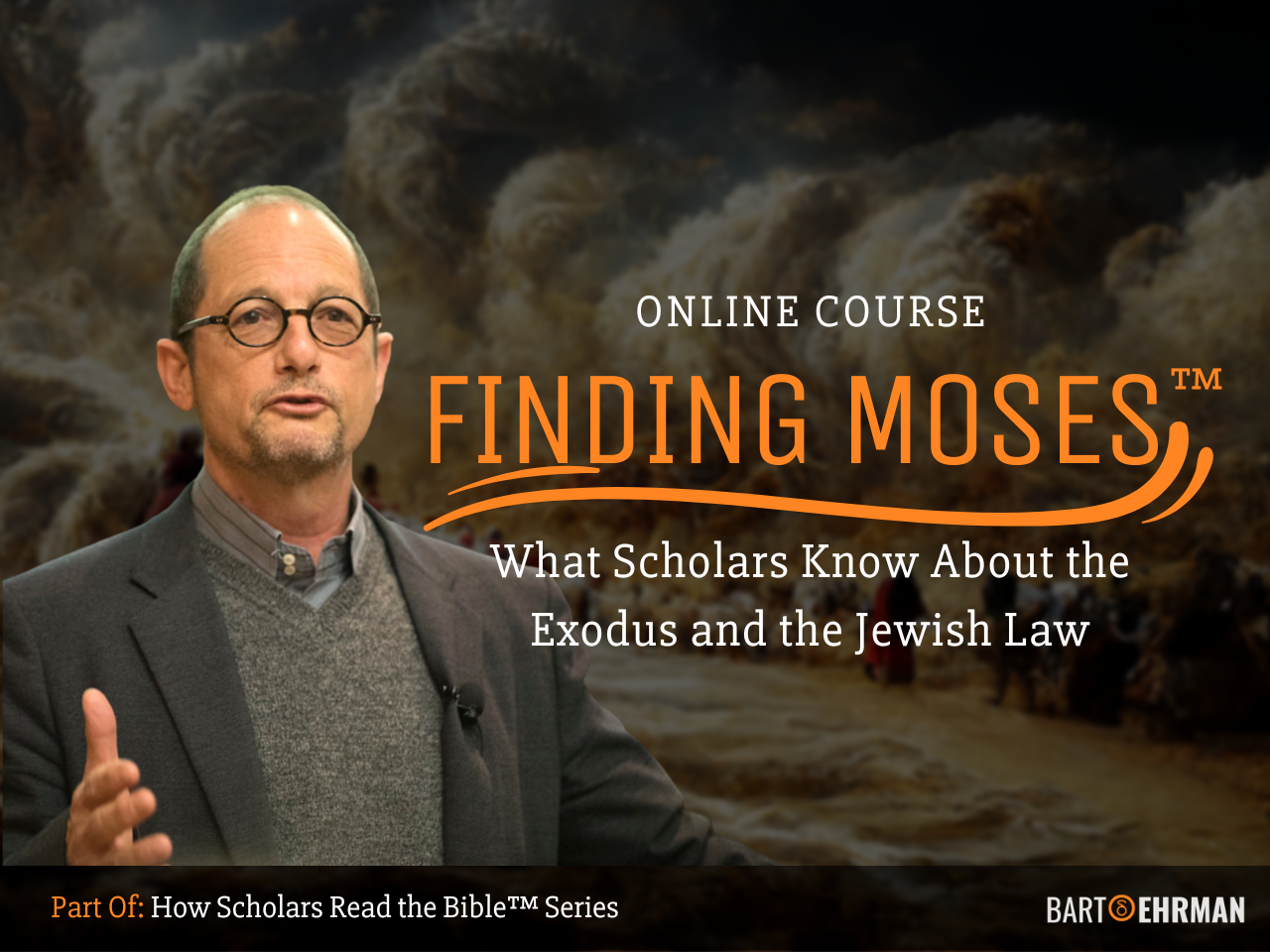Mosaic Law: Definition, Purpose, and Examples

Written by Marko Marina, Ph.D.
Author | Historian | BE Contributor
Verified! See our editorial guidelines
Disclaimer: The views and opinions expressed in this article belong to the author and do not necessarily match my own. - Dr. Bart D. Ehrman
In contemporary society, the term "Law" often conjures images of legal institutions, secular authorities, and a framework of rules recognized and enforced by a country to regulate the actions of its members. In this context, laws are primarily seen as mechanisms of governance and order, with the imposition of penalties for those who deviate from established standards.
However, to fully appreciate the concept of law in the ancient world, we must pivot our perspective from the secular to the sacred, particularly within the context of ancient Judaism. Unlike the primarily secular laws of modern states, ancient Jewish laws were deeply intertwined with religion and identity.
Among the myriad religious traditions that flourished in the ancient world, Judaism stood out for its profound emphasis on laws — not just as guidelines for moral and ritual conduct, but as foundational pillars of its very faith.
Central to this legal-religious framework is the "Mosaic Law," a comprehensive code believed to have been divinely revealed to Moses on Mount Sinai. Far more than a set of dos and don'ts, the Mosaic Law encapsulates a covenant between God and the Israelites, offering a detailed blueprint for worship, social justice, and personal conduct.
In this article, we aim to explore the intricate fabric of the Mosaic Law, delving into its definition, purpose, and the myriad examples that illuminate its role in ancient Judaism and its lasting influence on subsequent legal and ethical thought.

Books in the Ancient Judaism: Backdrop for the Mosaic Law
In the vast panorama of ancient religious movements, it was predominantly within the realms of Christianity and Judaism that a substantial body of literature came into existence. The religions of Greece and Rome, by contrast, exhibited a relatively casual approach to textual documentation.
While archaeological discoveries have unearthed ritual manuals, votive inscriptions, aretalogies, hymns, written oracles, and magical texts among these cultures, their scarcity and lack of association with specific cults render them peripheral rather than central to the religious practices of the time.
As highlighted by Harry Gamble, "No Greco-Roman religious group produced, used, or valued texts on a scale comparable to Judaism and Christianity."
For Judaism, texts held a paramount place as the bearers of the nation's authoritative cultural heritage, embodying religious, moral, social, and aesthetic values. Although not all Jewish traditions were codified in writing, it was the written word that garnered the highest reverence.
By the 1st century C.E., the Torah and the Prophets had already secured a pivotal role in Jewish life—a status that Greek or Roman literature could not rival. The meticulous preservation, transcription, study, and interpretation of Jewish scriptures were undertaken by scribes who approached these texts with the utmost respect.
This reverence, however, didn’t preclude the occurrence of errors in transcription. For those intrigued by the complexities of textual transmission and its implications, Dr. Bart D. Ehrman offers a compelling exploration of this topic in his course, "The Scribal Corruption of the Scripture."
This deep-rooted veneration for the written word sets a distinctive backdrop for understanding the significance of the Mosaic Law within Jewish tradition.
As we delve further into its definition, purpose, and impact, it becomes clear how this emphasis on the written text not only shaped the religious identity of the Jewish people but also established clear directions for Jews to follow in every aspect of their lives.
Mosaic Law: Definition and Historical Context
The Mosaic Law, foundational to the Jewish religion, is a comprehensive body of laws, commandments, and instructions that, according to Jewish belief, were given by God to Moses on Mount Sinai.
This extensive legal and ethical code is primarily documented in the Torah or Pentateuch. The law serves not only as a spiritual cornerstone but also as a guide for the moral, social, and religious life of the Jewish people.
It delineates the covenant between God and the Israelites thus setting forth the terms of their relationship and the behaviors expected of God's chosen people.
To grasp the historical context and significance of the Mosaic Law, one must consider a pivotal belief in Judaism: the covenant between God and the Jewish people, established through Moses at Mount Sinai.
This covenant is marked by a ceremony of divine proclamation and mutual agreement, vividly captured in Exodus 24:2-4.
Here, Moses conveys God's laws to the Israelites, who unanimously commit to obeying them. This moment, a climactic event in the narrative of the Pentateuch, signifies the formal initiation of the laws, rules, and instructions that would govern the ancient Israelites' lives.
From a historical perspective, Mosaic Law encompasses various chunks of laws that were penned down over several centuries but were integrated into the Sinai narrative and Israel's wilderness sojourn. This editorial decision sought to imbue these laws with an aura of ancient sanctity and divine endorsement.
Classification of the Mosaic Law in the Old Testament
According to Rabbi Simelai, the Mosaic law encompasses a broad spectrum of 613 commandments divided into 365 prohibitions (each corresponding to a day of the year) and 248 positive commands mirroring the number of bones in the human body.
As we traverse the Old Testament, the Mosaic Law unfolds in several distinct sections, each with its unique focus and form of law. These divisions help us appreciate the multifaceted nature of the law and its profound impact on daily and spiritual life in ancient Israel.
a) The Decalogue or Ten Commandments (Exodus 20:1-17)
The Ten Commandments, or "Ten Words" as referred to in the Hebrew Bible, form the bedrock of the Mosaic Law. German scholar Albrecht Alt identified two main types of law within biblical legal material: Conditional (casuistic) law and Absolute (apodictic) law.
The Ten Commandments fall into the latter category, providing unconditional directives like "You shall not murder," without specifying conditions or consequences. This absolute form is more prevalent in the Mosaic Law than in other ancient Near Eastern legal traditions.
Notably, the Decalogue was revealed directly to all of Israel, emphasizing basic, unconditional covenant demands, albeit primarily addressing Israelite males as the legal subjects. This leads us to the following question: What is the difference between the Mosaic Law and the 10 Commandments?
The Ten Commandments represent a core subset of the broader Mosaic Law, focusing on fundamental principles in absolute terms, while the Mosaic Law encompasses a wider array of regulations, including both absolute and conditional commands.
b) The Book of the Covenant (Exodus 21-23)
The next portion of the Mosaic law details "if/then" scenarios, embodying casuistic or conditional law. It covers a range of subjects from slavery to personal injury, resembling modern tort law in its approach to offenses and their redress.
The laws presented here are characterized by their seemingly random organization, touching upon slavery, personal injury, sorcery, oppression, and dietary laws. For example: “If you buy a Hebrew servant, he is to serve you for six years. But in the seventh year, he shall go free, without paying anything (Exodus 21:2).”
c) Instructions for the Tabernacle (Exodus 25-31; and 35-40)
The third aspect of the Mosaic Law is concerned with God’s instructions to Moses to build the Tabernacle - a sanctuary for the divine presence. These laws include detailed plans for its construction, furnishings, and the consecration of priests. It is written that God said to Moses: “Then have them make a sanctuary for me, and I will dwell among them (25:8).”
Furthermore, this section underscores the importance of sacred space in worship and includes a reminder of the Sabbath observance.
d) Sacrificial Laws (Leviticus 1-7)
These chapters outline various types of sacrifices, ranging from burnt offerings and grain offerings to sin and guilt offerings. Unlike the common perception that sacrifices were primarily about atonement for sins, they also included gifts of gratitude and devotion to God.
One such regulation specifies the requirements for a burnt offering: “If this offering is burnt offering from the herd, he is to offer a male without defect. He must present it at the entrance to the tent of meeting so that it will be acceptable to the Lord (1:3).”
e) Purity Laws (Leviticus 11-15)
This set of Mosaic laws deals with purity in daily life, culminating in the Day of Atonement rituals for cleansing both the Tabernacle and the people thus emphasizing the community’s collective sanctity.
One law from this section combined dietary restrictions with the prohibition against certain religious practices popular among the pagans: “Do not eat any meat with the blood still in it. Do not practice divination or seek omens. (19:26).”
f) Holiness Legislation (Leviticus 17-27)
Focusing on God’s holiness, these laws call upon the Israelites to live holy lives, reflecting God’s sanctity through their action and rituals. One such law is: “You shall not take vengeance or bear a grudge against the sons of your own people, but you shall love your neighbor as yourself: I am the Lord.” (19:18)
g) Priestly Laws (Book of Numbers)
Scattered throughout Numbers, the final portion of the Mosaic law revisits themes from Exodus and Leviticus but also adds new details or expands on earlier instructions. They cover a variety of topics, including purity, property rights, Sabbath observance, and offerings.
One law from this portion outlines how priests are to bless the people: “This is how you are to bless the Israelites. Say to them: 'The Lord bless you and keep you; the Lord make his face shine on you and be gracious to you; the Lord turn his face toward you and give you peace. (Numbers 6:23-26).
By categorizing the Mosaic Law into these sections, we gain a clearer understanding of its comprehensive nature and its guiding principles for both the spiritual and everyday lives of the Israelites. That brings us to the next issue: The Purpose of the Mosaic law for the ancient Jews.

Mosaic Law and Its Purpose
The Mosaic Law, with its extensive array of regulations and commandments, might initially appear to modern eyes as a cumbersome list of dos and don'ts. However, adopting such a view would miss the profound significance these laws held in the ancient Jewish community.
Far from seeing them as a burden, the Jews of antiquity took great pride in their covenant with God. This covenant not only set them apart as a chosen people but also affirmed the presence of a supreme deity who was actively involved in their lives.
As Nicholas de Lange observes: "Obedience to the law is real freedom: the law of God, as interpreted by rabbinic tradition, is not constraint but freedom, whereas what most people take for freedom is actually a kind of slavery.”
This perspective reveals a deep-seated appreciation for the Mosaic Law as a source of liberation rather than limitation.
Contrary to the broad application of "law" in modern English, which typically refers to regulations governing human interactions to protect various social, economic, and personal interests, the majority of the commandments within the Torah lean heavily towards religious obligations.
In fact, as Bill T. Arnold notes, only about 10 percent of these commandments address what we would consider legal matters in the narrow sense of establishing rights and duties among individuals.
The bulk of the Mosaic Law focuses on delineating the relationship between humans and God, establishing a framework within which this relationship operates. This distinction underscores the unique nature of the Mosaic Law as a blend of divine command and communal guidelines.
Moreover, the ancient Israelites' dedication to attributing the Mosaic Law to divine origin further elevates its importance within their society. Any deviation from these laws wasn’t merely a societal misstep but an offense against God Himself.
Therefore, in living according to these laws, the Israelites saw themselves as actively participating in a covenant relationship with God, making the Mosaic Law central to their communal, religious, and political existence.
Jesus, Paul, and the Mosaic Law
What did Jesus say about the Mosaic Law? Critical scholars largely concur that Jesus was an apocalyptic prophet who anticipated the imminent arrival of God's Kingdom on Earth and voiced strong criticisms against the religious leaders in Jerusalem, especially those overseeing the Temple rituals.
Yet, discerning Jesus' specific views on the Mosaic Law presents a challenging task. The Gospels, our primary sources for Jesus' teachings, were penned by early Christians several decades after Jesus’ death, each with their distinct perspectives and interpretations of the Law.
It's essential to remember that these texts were shaped by the early Christian community, which might have selected, reshaped, or even introduced new teachings attributed to Jesus regarding the Law.
In the Gospel of Matthew, for instance, we find a poignant declaration attributed to Jesus: "Do not think that I have come to abolish the Law or the prophets. I have come not to abolish but to fulfill (5:17)." This statement raises critical questions about its authenticity. Is this a genuine reflection of the historical Jesus' stance, or is it a perspective developed by Matthew's community?
John P. Meier, to take one notable example, would opt in favor of the latter option noting how some scholars uncritically use this passage to claim that the historical Jesus preached the strict observance of the Mosaic Law.
While these questions complicate our understanding, it's widely acknowledged among scholars that Jesus, deeply rooted in his Jewish heritage, engaged extensively with the Mosaic Law. His interactions, often depicted as debates with Pharisees and Sadducees, suggest a nuanced approach to the Law.
Contrary to the Pharisees, Jesus seemed to argue that meticulous adherence to the law's minutiae wasn’t paramount for righteousness before God. Similarly, he diverged from the Sadducees by downplaying the centrality of Temple worship and sacrifices as the sole means to maintain a relationship with God.
As noted by Bart D. Ehrman, for Jesus, the essence of the Law was encapsulated in the commandments to love God wholeheartedly and to love one's neighbor as oneself (Mark 12:28-34). This focus on love as the core of the Law suggests a reinterpretation of Jewish legal traditions, emphasizing ethical conduct in preparation for Judgment Day and the establishment of the Kingdom of God.
What did Paul say about the Mosaic Law? Paul was also deeply imbedded within the Jewish tradition, but his theology was primarily based on a profound religious experience that he interpreted as the encounter with the risen Jesus who commanded him to spread the good news to the Gentiles.
In his Epistle to Galatians, Paul advocates for the universal application of the gospel. For him, both Jews and Gentiles are justified or made righteous by having faith in the risen Jesus, not by getting circumcised and following the Law. As he notes: “If righteousness comes through the law, then Christ died for nothing (2:21).”
The purpose of the Mosaic Law, for Paul, was to guard people until faith comes. Living by the Law was meant to be a temporary solution until faith arrived. He notes: “Thus the law had become our guardian until Christ so that we could be declared righteous by faith (3:24).”
However, we must be careful not to insert wrong (modern) distinctions into the world of Apostle Paul. His letter to Galatians was only addressed to the Gentiles who believed in Jesus. They shouldn’t get circumcised and become Jews because they are made righteous only by faith in the risen Jesus.
As Bart Ehrman explains: “For Paul, Gentiles who underwent circumcision showed a complete and absolute misunderstanding of the meaning of the Gospel… It was an affront to God and a rejection of the justification by faith he has provided through Christ.”
But Paul probably thought that it was perfectly reasonable for Jewish believers in Jesus to circumcise their sons and to keep kosher - after all, they were Jews. It was assumed that they would keep observing the Mosaic Law. But they would also need to understand it was their faith in Jesus that made them righteous, not the observance of the Law.
Summing up Conclusions
In conclusion, the journey through the Mosaic Law, from its inception to its enduring influence on religious thought and practice, unveils a complex tapestry of legal, ethical, and spiritual dimensions.
This exploration has illuminated how, within the ancient Jewish tradition, the Law served not merely as a set of regulations but as a profound expression of a covenantal relationship with God thus shaping the community's identity in various ways.
Furthermore, the reflections on the perspectives of Jesus and Paul regarding the Mosaic Law enrich our understanding of its significance and reinterpretation within the early Christian movement. This scholarly inquiry, grounded in historical and textual analysis, invites readers to appreciate the Mosaic Law's complexity and its pivotal role in shaping Judeo-Christian ethical and religious thought.

